Making Gyoza
Okay, settle down here, because this will be a long post–not necessarily in words, but in inches (or centimeters, as the case may be. A friend recently taught me how to make gyoza (sometimes spelled ‘gyouza’), often called ‘potstickers’ in English. They are essentially a vegetable mix, with meat optional, encased in a small dough wrapping and steamed or fried before serving. I like gyoza, but the ones I get at stores tend to be far less than satisfying–but I found that I really like the homemade ones. The ones I’m showing today are made with chicken. Please note that the amounts of ingredients are approximate–they can easily be increased or decreased to suit your taste. Keep in mind I am no cook, nor a cookbook writer, so this could be a bit messy! Here is the basic setup for cooking:

1/2 head of cabbage or less (you won’t use it all by a long shot, but usually you can’t buy less)
1/2 onion
part of a clove of garlic (use however much you prefer)
one bunch “nira” (leeks)
one bunch “negi” (umm… also leeks, but a different kind. I like the thin type, shown above)
1 to 3 packages large gyoza wrappings (depends how many you plan to cook now)
Sesame oil (“gomayu”)
Seasonings (I use salt and pimenton)
Ground chicken meat (around 250 grams, or half a pound, roughly)
You’ll also need a little flour with water, a largish mixing bowl, a long, sharp knife, a regular spoon, and a frying pan with a cover. Keep in mind that these are just the suggested portions. You can change the amount of any ingredient to your taste, and even add or subtract filling ingredients.
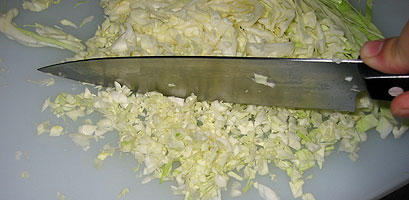 First, slice some cabbage, perhaps three or so quarter-inch thick slices from the middle of the head. Discard any bulky pieces too close to the stem, then start chopping, until you’ve reduced it to tiny pieces. The amount you’ve chopped should amount to about a cup, slightly packed. When finished, throw them into the mixing bowl.
First, slice some cabbage, perhaps three or so quarter-inch thick slices from the middle of the head. Discard any bulky pieces too close to the stem, then start chopping, until you’ve reduced it to tiny pieces. The amount you’ve chopped should amount to about a cup, slightly packed. When finished, throw them into the mixing bowl.
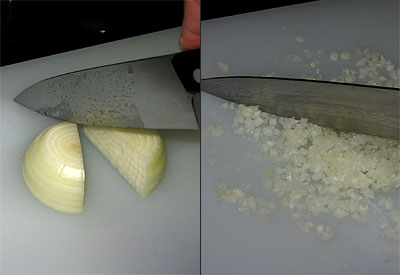 Next, take half an onion (just a regular white onion), and chop it into similarly small pieces. Then throw those into the bowl, too.
Next, take half an onion (just a regular white onion), and chop it into similarly small pieces. Then throw those into the bowl, too.

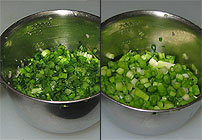
Then chop the leeks, not just slicing the bits off, but chopping those into finer bits as well. Each type should produce about a quarter of a cup. Into the mixing bowl they go.
 Take whatever amount of garlic, if any, that you prefer–I took three lobes, or whatever you call them–and grate/crush them. Add this to the mixing bowl as well.
Take whatever amount of garlic, if any, that you prefer–I took three lobes, or whatever you call them–and grate/crush them. Add this to the mixing bowl as well.

This is what you should have by now.
Now, for the meat, I like to use ground chicken. Ground beef was way too dry; ground pork was OK, but chicken makes the gyoza much juicier, in my humble gourmet opinion. I use the fattier ground chicken, in fact.
Update: At this point, you may want to add cheese. I have found that shredded cheese, added to taste, can make the gyoza even more tasty. I use mozzarella, grated, about half a cup.
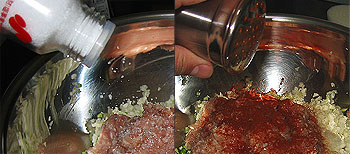 After the chicken is added, top it off with the seasonings you prefer. Salt and pepper are safe bets. I use pimenton (smoked Spanish pepper spice) because, well, I use it on everything. So on it goes.
After the chicken is added, top it off with the seasonings you prefer. Salt and pepper are safe bets. I use pimenton (smoked Spanish pepper spice) because, well, I use it on everything. So on it goes.


Finally, pour on some sesame oil. Don’t be stingy, but don’t create a flood, either. Maybe 1/4 cup or so will do, though I’m just estimating here. And then–eeewwwwwww!!–go in with both hands and squish, squash, and knead all of it together until it is well-mixed. Then go wash your hands, for god’s sake!
 OK, here are the shells to use. They come in different sizes and thicknesses. I always go for the large ones, partially because I like big gyoza, but also because the smaller ones create a lot more work–you have to make more, and as you’ll see, the shell crimping can be time-consuming. I have no preference between the thick and thin types. Here I am using the thin ones. You can usually find them in your (Japanese) supermarket near the ground meats; if not, ask. The ones I use come in packages of 20.
OK, here are the shells to use. They come in different sizes and thicknesses. I always go for the large ones, partially because I like big gyoza, but also because the smaller ones create a lot more work–you have to make more, and as you’ll see, the shell crimping can be time-consuming. I have no preference between the thick and thin types. Here I am using the thin ones. You can usually find them in your (Japanese) supermarket near the ground meats; if not, ask. The ones I use come in packages of 20.
 Have the gyoza filling mix in the mixing bowl handy, as well as an empty plate to put the finished gyoza. Get a small dish or saucer, and put a small amount of flour (a teaspoon, perhaps, no more) onto it, then add a little water; mix some flour into the water until it becomes milky, but not very thick. Open the gyoza shell package, and take out some of the round shells; we’re gonna wrap some potstickers!
Have the gyoza filling mix in the mixing bowl handy, as well as an empty plate to put the finished gyoza. Get a small dish or saucer, and put a small amount of flour (a teaspoon, perhaps, no more) onto it, then add a little water; mix some flour into the water until it becomes milky, but not very thick. Open the gyoza shell package, and take out some of the round shells; we’re gonna wrap some potstickers!
Here comes the difficult part of the recipe; it may take you several attempts to get decent at it, so be patient. First, take a shell into the palm of one hand, and then spoon out some gyoza filling into its center; see the photo above for the amount. Less than a spoonful to be certain–for the first few, less is better than more (when you close the shell, a few steps later, there should be maybe a third or half an inch of border around the filled center). There’s lots of filling here, so go ahead and waste a few if needed.
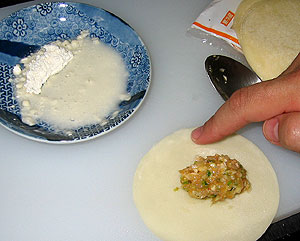 Next, dip the tip of your finger into the flour-water, and apply this to the border of half the gyoza shell (the same side the filling is on), so as to mark out a semi-circle. Only spread enough with your finger to cover the surface of the edge and make it sticky; it should not run wet. This acts like a glue, and is to get the shell to stay closed. In the photo above, I have set the shell on the cutting board only because I needed a hand free to snap the photo; usually, I wet the edges while holding the shell in my other hand.
Next, dip the tip of your finger into the flour-water, and apply this to the border of half the gyoza shell (the same side the filling is on), so as to mark out a semi-circle. Only spread enough with your finger to cover the surface of the edge and make it sticky; it should not run wet. This acts like a glue, and is to get the shell to stay closed. In the photo above, I have set the shell on the cutting board only because I needed a hand free to snap the photo; usually, I wet the edges while holding the shell in my other hand.
Next can be the trickiest part:
 You’re going to have to close the shell, but not just in a smooth, straightforward manner. You will have to crimp one side of the border, making creases along the way. Different people have different techniques for this. My way is to bring the two halves of the shell together and close them just at the center point, leaving the sides temporarily open. Then, working from the top/center, I take some slack from the far side of the shell (as you see in the above illustration, I start on the right side), creating the crease–then pressing down hard to seal them together. I do this twice on the right, and twice on the left, for four creases; you do what suits you.
You’re going to have to close the shell, but not just in a smooth, straightforward manner. You will have to crimp one side of the border, making creases along the way. Different people have different techniques for this. My way is to bring the two halves of the shell together and close them just at the center point, leaving the sides temporarily open. Then, working from the top/center, I take some slack from the far side of the shell (as you see in the above illustration, I start on the right side), creating the crease–then pressing down hard to seal them together. I do this twice on the right, and twice on the left, for four creases; you do what suits you.
The finished product should look something like this:

Note the creases in the shell are only on the one side (call it the “top” now), and the other side should be flat. Note also that the filling should not come close to the edge, with a 1/3 or 1/2 of an inch border.
Continue dalloping, gluing, folding, crimping and pressing, until you have the desired number of gyoza. Usually 12 or so are enough for someone with a good appetite; Hiromi, my friend Ken and I found that 40 gyoza serve three people quite nicely, along with a salad and drinks. The amount of filling that this recipe generates is enough for 40 gyoza, possibly 45 (or even 50 if you use less filling in each). If there is filling left over after you finish (as I had tonight), then drop it into a ziploc and refrigerate it; more gyoza for tomorrow!
In the end, your plate might look like this:

I made 14 here, just for myself (me, hungry).
 Now, prepare the frying pan by pouring a small amount of oil (olive oil would be great here) into the pan, then spread it around with a square of paper towel; there should be enough to slightly ‘wet’ all the gyoza as you place them down. Do not pour so much that the whole pan bottom is covered; to the contrary, keep it very light, so that all the oil can be absorbed easily into the gyoza.
Now, prepare the frying pan by pouring a small amount of oil (olive oil would be great here) into the pan, then spread it around with a square of paper towel; there should be enough to slightly ‘wet’ all the gyoza as you place them down. Do not pour so much that the whole pan bottom is covered; to the contrary, keep it very light, so that all the oil can be absorbed easily into the gyoza.
Next, place the gyoza into the pan; up to twenty should fit at a time. Don’t worry if they touch. Fry the gyoza at low heat without a cover, until the bottom of the gyoza are brown; then raise the heat a touch for a moment. Then, with the pan cover in one hand, take a cup of water in the other and pour it into the frying pan, then quickly cover the top as the water turns to steam.

Keep the top on for five minutes at least, perhaps more, checking periodically; when the water has all but steamed off and there is just a bit of water and oil left in the pan, the gyoza may be done. If the water has gone but you think more cooking may be in order, add a bit more water and cover again.
 When the gyoza are done, take the pan to your kitchen sink. Drain any excess water (there shouldn’t be any if you did it right), then uncover the pan, and put a dinner plate, upside-down, over the gyoza. Holding the plate with one hand, turn the pan over with the other, then remove the pan from atop; the gyoza should now be nicely placed on the plate.
When the gyoza are done, take the pan to your kitchen sink. Drain any excess water (there shouldn’t be any if you did it right), then uncover the pan, and put a dinner plate, upside-down, over the gyoza. Holding the plate with one hand, turn the pan over with the other, then remove the pan from atop; the gyoza should now be nicely placed on the plate.
Congratulations–you’ve got gyoza! Gyoza need a dipping sauce, so in a small saucer, pour some soy sauce, and then some sesame oil. I top that with (of course) a little pimenton. Serve the gyoza from the central plate, allowing everyone to take from it and dip in their saucer.

Enjoy!

Damn: now I’ve got a gyoza craving, and its near bedtime!
Sorry! (Heh heh!)
A certain amount of sugar, sake, ginger, and soy sauce should be added. I can’t help you with the portions because I have only made gyoza filling 50 lb batches, enough to make several hundred gyoza. It was part of my morning duties for three years at a ramen shop to prepare the filling, the wrappers and the noodles from scratch every day.
I forgot to mention the name of the chain. Fuji-Ichiban Ramen from Nagoya but my branch is on Guam.
FANTASTIC! love the recipe and the photos with it, as well. Will try it out once I’m back home.
I AM SOOOOOOOOOOOOOOOO HAPPY I FOUND THIS…I LOVE GYOZA..mMMMMMm….i just moved to japan a month ago and since then have been living with a homestay family that cooks marvelous meals..i will now be living in my own apartment and cooking for myself so this definitely helps ..thanks a MILLION
Diva:
You’re welcome. Bon app?tit!
this is brilliant now i can make gyoza at home in australia … i got hooked on them when i was in japan and have been telling everyone how fantastic they are. the sauce i was having with them was thicker and sweeter than this one … any ideas what it might be
Sirine:
The sauce might have been a thicker “tare” sauce of some kind. Was it made for gyoza, or did you just pick it up and use it that way? Whichever the case, you are probably limited anyway to whatever you can find in the markets.
As for me, the soy sauce-sesame oil combination works just fine, you should try it.
Cheese? Pimenton? Certainly not your traditional gyoza recipe, though it wouldn’t surprise me to see cheese gyoza on a menu in Tokyo. After all, I’ve seen cheese curry and cheese ramen all over the Tokyo… I’ve never had pimenton, but I imagine it’s good. But why don’t you use La Yu (or other chili oil) in your dipping sauce instead of the sesame oil and pimenton? and rice vinegar?
By the way, great photos–definitely got me craving gyoza. I think I might try that cheese suggestion of yours.
I am addicted to these things and need a weekly dose but I wish I could afford it more often.
Julia.
Thanks heaps! I have used this recipe and made gyoza and they were amazing! I changed a few parts – by adding finely diced water chestnuts to the mix and a little chilli to the sauce. Delicious! Brilliant page!
You are a legend! After nearly 2 years in Japan I finally understand how to cook and serve gyoza properly. And now I know exactly how to make them too! Eternally grateful.
Thank you for the recipe, later I will use the gyoza to taste the different.
later I will use the gyoza to taste the different.
Just now I made it, I use ground beef andthe sauce is mix of vinegar, chili crush pepper, soy sauce and granulad sugar.
The taste is so so good. I used to make dumpling either boiled it or fry it, but this technic new for me and bet more healthy but taste better…
I use wonton skin instead of gyoza skin because that is what is in the kitchen
great post. i love gyoza and enjoy making them almost as much as eating them.
not sure about that cheese part
i like to add a little sugar to the mixture and the dipping sauce(s).
it’s often suggested to chill the mixture before you start filling, i think it let’s the meat absorb the flavors as well as makes it easier to stuff).
itadakimasu
I love Gyoza!
The step by step explaination and pictures were great.
I’m definitly going to try this receipe at home.
Thank you! : ) *Cristi
I love Gyoza!
The step by step explaination and pictures were great.
I’m definitly going to try this receipe at home.
Thank you! : ) *Cristi
Of all the reciepe sites I’ve been to, yours is the most comprehensive and
easy to use. Thank you so much for taking the time to share this!!! The tip from Roy in Guam I aslo very much appreciate because I lived there and STILL crave Fuji Ichiban’s Gyoza and Ramen!! Now maybe maybe maybe I can come close. I orginally was looking for a gyoza dipping sauce like that of Fuji Ichiban,…any ideas?
Enjoyed your photos, you did a great job. I lived in Japan for 3yrs Gyoza is like spaghetti, we all make it different. I use Hamburger no white onions just the green,and I cheat by using finely shredded slaw cabbage its much quicker and 1/2 C shredded carrot, and minced garlic. I love the fried un-steamed version and the sauce I dip it in is soy sauce and Rayu (a chili oil) all asian stores have it. It is spicy so use accordingly…
Thank You, Joanne- former Iwakuni resident.
love tne recipe and did some substituting prawn for pork
but did find it hard to get neri so used shallots
Just some additional notes that might be useful for UK readers in particular:
The traditional recipe definitely calls for ginger: about half a teaspoon to a teaspoon of finely-grated fresh ginger to every half-pound of meat.
As for the meat, you could also use minced prawn or a 50%/50% mixture of pork and chicken.
Regarding the green stuff, in the UK we use “spring onions” (in the US, I believe they’re called “salad onions”). In the UK, “leeks” are bigger and thicker and are not quite the same, although they would taste pretty similar admittedly, as they’re all part of the same onion family.
?8-)
-Michael.
Thanks for the recipe. I remember going to a restaurant in the Hakone area of Japan called “Gyoza Center” that had quite a range of variants on the basic gyoza recipe including ingredients like kimchi and gingko nuts (maybe even cheese?). I wish I could remember more of them to try out. Anyone out there have any suggestions for alternative ingredients that they have tried out?
wow!!
great tasting treat!
thank you for the recipe!
I love Gyosa
I live in south brazil and eastern foods are not exactly well known. Thanks for the recipe.
My favorite dipping sauce is a little shoyu, very little vinegar and tabasco or equivelent…than I eat the gyosa wraped in a lettuce leaf with a leaf of peppermint.
this same mix is good with springrolls too…
Thanks for the info
Hi – I am going to try these this afternoon, or a variation based on your recipe, to post on my food blog (with links to your site, of course!). I ahve been looking at various sites for gyoza recipes, and yours looks to me to pretty good. Thanks a lot!
Good recipe, very similar to my own… I don’t have access to two different types of ‘green onion’ (leeks), but i also don’t use any white onion. I also add 1tbsp minced fresh ginger, and 2tbsp unpacked chopped cilantro, as well as 1/2 to 1 tsp of citrus zest… don’t know if cilantro is available in japan, but by doctoring your recipe that way, your friends may start calling you iron chef of gyoza…
I want the Companions recipe, I spent 3 years in Misawa and never bothered to get it! Can you help me I am dying here!!
Sorry, the “Companions recipe”? What’s that?
I’ve been browsing for gyoza recepies all evening. This is the only one I have seen that is worth commenting. This is a beautifully presented, illustrated and explained recipe. I can hardly wait for this weekend when I plan to make gyoza – this will certainly be my first choice for the recipe! Thank you, thank you!
Has anyone tried the gyoza folding thingy’s you can buy in the 100yen shops?
Also whilst I rarely find a place that does bad gyoza, one of the best I have tried do not put the water in at the end. They cover with alfoil when first put on the fryer. So they cook through as they are frying and are much less ‘squishy’ than the traditional gyoza.
Great job with the pictures and descriptions. I didn’t even know that “pot stickers” were supposed to be the same thing as the gyoza that I ate in Japan! You brought back many memories for me. Thanks.
I was station in Iwakuni, Japan in the mid-1970s. There was a little corner restaurant (little red doors), the only thing they made and served seemed to be gyoza. The place only sat a couple of people at a counter and maybe a small table of four. We would order three plates at a time! I think the owners / cooks thought we were crazy!
They had the soy sauce type sauce, but there was also a small glass bottle with a little glass rod which you would dip into the bottle and drip drops of some spicey hot clear seasoning into the soy sauce.
Question: What was the clear liquid seasoning?
Rich
Luis,
I know it has been awhile for a post to this section. The individual who was talking about “Companions” for gyoza was talking about a small shop located near Misawa AB. When I was stationed there in 1986, Companions made the best cheese gyoza, yakitori and yakisoba I have ever had. I wish as well I had the recipe for their food. Back then, when the yen rate was 264 to the dollar, paying 500 yen for both gyoza and yakisoba was a pretty good meal. I tried your gyoza recipe and found it excellent. I do miss Japan. especially Lake Towada and the coast. I also love redimg your Blog, keep it up!